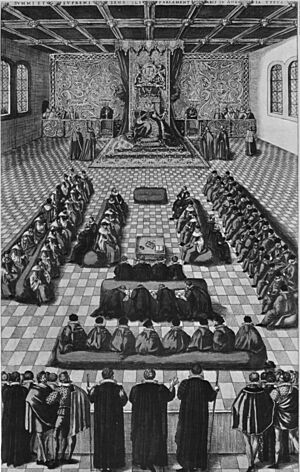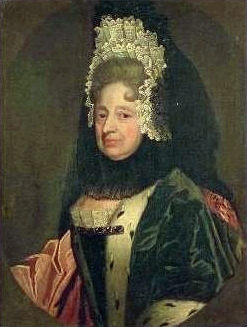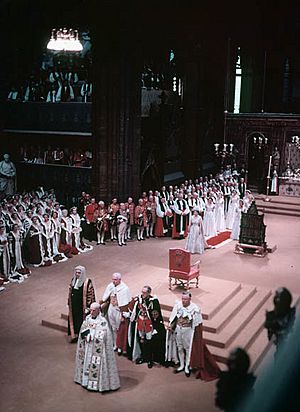Succession to the British throne facts for kids
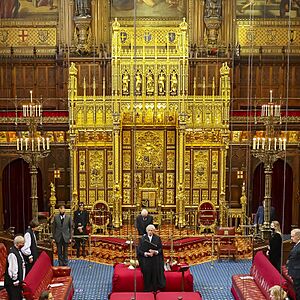
The way someone becomes the British King or Queen is decided by who they are related to, their gender, if their parents were married, and their religion. This system is called the "succession to the British throne."
For hundreds of years, the Crown (the symbol of the monarch's power) was passed down to the sovereign's children. If there were no children, it went to the closest relative in another family line. Important laws like the Bill of Rights 1689 and the Act of Settlement 1701 say that only certain Protestant descendants of Sophia of Hanover can become monarch. They must also be part of the Church of England. Until 2015, if someone in line to the throne married a Catholic, they would lose their place. But this rule has now changed.
Today, King Charles III is the monarch. His eldest son, William, Prince of Wales, is next in line. William's oldest son, Prince George of Wales, is third, followed by his sister, Princess Charlotte, and his younger brother, Prince Louis. The King's younger son, Prince Harry, Duke of Sussex, is fifth in line, and Harry's oldest child, Archie Mountbatten-Windsor, is sixth.
Since 2015, only the first six people in line to the throne need the monarch's permission to get married. If they don't get permission, they and their children cannot become monarch.
The first four people in the line of succession who are over 21, along with the monarch's husband or wife, can become "counsellors of state." These counsellors can do some of the monarch's jobs in the United Kingdom if the monarch is away or unable to perform their duties.
The United Kingdom is one of 15 Commonwealth realms. These are countries that all have the same person as their monarch and follow the same rules for who becomes monarch next. In 2011, the leaders of these countries agreed to change the rules. Now, for anyone born after October 28, 2011, the oldest child, no matter if they are a boy or a girl, comes first in line. Before this, boys would come before their older sisters. The ban on marrying Catholics was also lifted, but the monarch still needs to be a member of the Church of England. These changes officially started on March 26, 2015.
Contents
Who is Next in Line to the Throne?
| First six in line | |
|---|---|
| 1. William, Prince of Wales | |
| 2. Prince George of Wales | |
| 3. Princess Charlotte of Wales | |
| 4. Prince Louis of Wales | |
| 5. Prince Harry, Duke of Sussex | |
| 6. Archie Mountbatten-Windsor | |
There isn't one official, complete list of everyone who could possibly be in line to the throne. It's hard to know the exact number of people in very distant family lines who might be eligible. In 2001, a genealogist (someone who studies family histories) named William Addams Reitwiesner made a list of 4,973 living descendants of Electress Sophia. By 2011, that number had grown to 5,753.
The list below shows the first part of the line of succession. It includes descendants of the sons of George V, who was King Charles III's great-grandfather. The first 23 people on the list are all descendants of Queen Elizabeth II. Their order was shown on the official website of the British monarchy before she passed away.
 King George V (1865–1936)
King George V (1865–1936)
 King Edward VIII (1894–1972)
King Edward VIII (1894–1972) King George VI (1895–1952)
King George VI (1895–1952)
 Queen Elizabeth II (1926–2022)
Queen Elizabeth II (1926–2022)
 King Charles III (b. 1948)
King Charles III (b. 1948)
* (1) William, Prince of Wales (b. 1982) ** (2) Prince George of Wales (b. 2013) ** (3) Princess Charlotte of Wales (b. 2015)
**- (4) Prince Louis of Wales (b. 2018) * (5) Prince Harry, Duke of Sussex (b. 1984) **
- (6) Archie Mountbatten-Windsor (b. 2019) **
- (7) Lilibet Mountbatten-Windsor (b. 2021)
-
-
-
- (8) Prince Andrew, Duke of York (b. 1960)
-
-
-
- (10) Sienna Mapelli Mozzi (b. 2021) * (11) Princess Eugenie (b. 1990) **
- (12) August Brooksbank (b. 2021)
-
-
-
- (13) Prince Edward, Earl of Wessex (b. 1964)
-
-
-
- (15) Lady Louise Mountbatten-Windsor (b. 2003)
-
-
-
- (16) Anne, Princess Royal (b. 1950)
-
-
-
- (19) Isla Phillips (b. 2012) *
- (20) Zara Tindall (née Phillips; b. 1981) ** (21) Mia Tindall (b. 2014) **
- (22) Lena Tindall (b. 2018) ** (23) Lucas Tindall (b. 2021)
-
-
- Princess Margaret, Countess of Snowdon (1930–2002)
- (24) David Armstrong-Jones, 2nd Earl of Snowdon (b. 1961)
- Princess Margaret, Countess of Snowdon (1930–2002)
-
-
- (26) Lady Margarita Armstrong-Jones (b. 2002)
-
-
-
- (27) Lady Sarah Chatto (née Armstrong-Jones; b. 1964)
-
-
-
- (29) Arthur Chatto (b. 1999)
-
- Prince Henry, Duke of Gloucester (1900–1974)
- Prince William of Gloucester (1941–1972)
- (30) Prince Richard, Duke of Gloucester (b. 1944)
- (31) Alexander Windsor, Earl of Ulster (b. 1974)
- Prince Henry, Duke of Gloucester (1900–1974)
-
- (33) Lady Cosima Windsor (b. 2010)
-
-
-
- (34) Lady Davina Windsor (b. 1977)
-
-
-
- (36) Tāne Lewis (b. 2012)
-
-
-
- (37) Lady Rose Gilman (née Windsor; b. 1980)
-
-
-
- (39) Rufus Gilman (b. 2012)
-
- Prince George, Duke of Kent (1902–1942)
- (40) Prince Edward, Duke of Kent (b. 1935)
- (41) George Windsor, Earl of St Andrews (b. 1962)
- (40) Prince Edward, Duke of Kent (b. 1935)
- Prince George, Duke of Kent (1902–1942)
-
- (42) Lady Amelia Windsor (b. 1995)
-
-
-
- Lord Nicholas Windsor (b. 1970)
-
-
-
- (45) Louis Windsor (b. 2014)
-
-
-
- (46) Lady Helen Taylor (née Windsor; b. 1964)
-
-
-
- (50) Estella Taylor (b. 2004)
-
-
- (51) Prince Michael of Kent (b. 1942)
- (52) Lord Frederick Windsor (b. 1979)
- (51) Prince Michael of Kent (b. 1942)
-
-
- (54) Isabella Windsor (b. 2016)
-
-
-
- (55) Lady Gabriella Kingston (née Windsor; b. 1981)
- (56) Princess Alexandra, The Honourable Lady Ogilvy (b. 1936)
- (57) James Ogilvy (b. 1964)
-
-
-
- (59) Flora Vesterberg (née Ogilvy; b. 1994)
-
-
-
- (60) Marina Ogilvy (b. 1966)
-
-
-
- (62) Zenouska Mowatt (b. 1990)
| Mark | Source for listing or note on exclusion from succession |
|---|---|
| 1952 | Succession published on the accession of Queen Elizabeth II in 1952 |
| B | Listed by the official website of the British monarchy, "Succession", retrieved 9 September 2022. |
| D | Debrett's website (as of 21 October 2021[update]): "The Line of Succession" (subscription needed) |
| W | Whitaker's Almanack 2015, London: Bloomsbury, ISBN: 978-1-4729-0929-9, p. 22 |
| M | These people had been excluded through marriage to a Roman Catholic. This exclusion was repealed on 26 March 2015, restoring them to the line of succession, when the Perth Agreement came into effect. |
| X | Excluded as Roman Catholics. This exclusion is not affected by changes subsequent to the Perth Agreement. |
How the Rules of Succession Changed Over Time
Early English History
In 1485, Henry Tudor became King Henry VII after winning a big battle. He made a law that said the Crown would pass to him and his legal children.
His son, Henry VIII, became king next. Henry VIII had many wives, which made the rules of succession complicated. He had a daughter, Mary, with his first wife, and another daughter, Elizabeth, with his second wife. His third wife gave birth to a son, Edward. Laws were passed that changed who was in line for the throne. Henry VIII even made a will to decide who would rule after him, including his daughters Mary and Elizabeth.
When Henry VIII died in 1547, his young son Edward became King Edward VI. Edward was the first Protestant king of England. He tried to change the succession rules in his own will to stop his Catholic half-sister, Mary, from becoming queen. He wanted his cousin, Lady Jane Grey, to rule instead. When Edward died in 1553, Lady Jane Grey was declared Queen. But she was only queen for nine days before Mary took the throne, as Henry VIII's will was the legal one.
Mary was followed by her half-sister, Elizabeth. Queen Elizabeth I chose not to name an heir. Parliament then made it clear that they had the right to decide who would be the next ruler.
Scotland's Royal Family
The House of Stewart (later Stuart) ruled Scotland from 1371. They had very strict rules about who would inherit the throne, usually the oldest child.
After England and Scotland United
The Stuart Kings and Queens
After Elizabeth I died, James VI of Scotland became King James I of England and Ireland. This joined the crowns of England, Scotland, and Ireland, even though they were still separate countries until 1707.
James's son, Charles I, became king but was later overthrown and executed in 1649. For a while, England didn't have a king, but was led by Oliver Cromwell. Later, the monarchy was brought back, and Charles I's son, Charles II, became king.

James II and VII, who was Catholic, became king after his brother Charles II. But in 1688, his Protestant opponents forced him to leave England. Parliament then decided that James had given up the throne. They offered the Crown not to James's baby son, but to his Protestant daughter Mary and her husband William. They ruled together as William III and Mary II, which was very unusual.
The English Bill of Rights 1689 and the Scottish Claim of Right Act, both passed in 1689, set the rules for who would inherit the thrones. Only Protestants could become monarch, and anyone who married a Catholic was not allowed to rule.
After Mary II died in 1694, William continued to rule alone. Since William and Mary had no children, and Princess Anne's children had all died, the line of succession was almost empty. So, Parliament passed the Act of Settlement 1701. This Act said that after Princess Anne and her children, the throne would go to Sophia, Electress Dowager of Hanover, and her descendants. Like before, non-Protestants and those who married Catholics were excluded.
When William died, Anne became Queen. Because the English Parliament chose Sophia as Anne's heir without asking Scottish leaders, Scotland passed its own law, the Act of Security. This law said that after Anne died, Scotland would choose its own heir, who might not be the same person as the English monarch. To avoid problems, England and Scotland united in 1707 to form the Kingdom of Great Britain. The new country's crown followed the rules of the English Act of Settlement.
The Hanover and Windsor Families
Queen Anne died without any surviving children. Sophia of Hanover had died before Anne, so Sophia's son became King George I in 1714.
There were attempts to bring back the Stuart family, but the House of Hanover remained on the throne. In 1801, Great Britain and Ireland officially united to become the United Kingdom of Great Britain and Ireland.
When William IV died in 1837, his 18-year-old niece Victoria became queen. She ruled for 63 years. After her, her eldest son Edward VII became king.
In 1936, Edward VIII became king after his father, George V, died. However, Edward wanted to marry Wallis Simpson, who was divorced. The Church of England, which the monarch leads, did not allow the marriage of divorced people. So, Edward VIII decided to give up his throne in December 1936. A law was passed that said he and any future children would not have any claim to the throne. Edward died in 1972 without children.
Edward's brother, the Duke of York, immediately became king, taking the name George VI. He was succeeded in 1952 by his older daughter, Elizabeth II. By this time, the monarch of the United Kingdom was also the monarch of many other independent countries, known as Commonwealth realms. She was then succeeded in 2022 by her oldest son, Charles III.
How Succession Works in Commonwealth Realms
Thanks to a law called the Statute of Westminster 1931, all the Commonwealth realms have the same person as their monarch. To keep this going, they agreed to follow the same rules for succession.
In October 2011, the leaders of all 16 realms met in Perth, Australia. They all agreed to change the royal succession laws. For people born after October 28, 2011, the oldest child, regardless of gender, would be first in line. They also agreed to allow people in line to the throne to marry Roman Catholics. However, the monarch themselves must still be a Protestant and in communion with the Church of England. These changes became law in all Commonwealth realms on March 26, 2015.
Because of these changes, the positions of the first 27 people in line stayed the same until Princess Charlotte was born on May 2, 2015. The first people to be affected by the changes were the children of Lady Davina Lewis: her son Tāne (born 2012) and her daughter Senna (born 2010). Their order in the line of succession switched, with Senna becoming 28th and Tāne becoming 29th.
Current Rules for Becoming Monarch
The Bill of Rights and the Act of Settlement still guide who can become monarch. These laws were updated in the United Kingdom by the Succession to the Crown Act 2013. This Act made sure that succession doesn't depend on gender anymore and changed rules about royal marriages. Other Commonwealth realms passed their own laws to make these changes happen.
If someone is not allowed to succeed, it's as if they don't exist in the line of succession. But their children can still be in line, unless they also have a reason not to be.
Marriage Rules
The Act of Settlement 1701 says that Protestant descendants of Sophia of Hanover can become monarch, unless there's a reason they can't. The rules used to say that boys came before girls, but for people born after October 28, 2011, the oldest child comes first, regardless of gender. Children born outside of marriage or adopted children cannot become monarch.
Before 2013, a law called the Royal Marriages Act 1772 said that many descendants of George II needed the monarch's permission to marry. If they married without permission, the marriage was not considered valid for succession purposes, and their children could not inherit the throne. This law was removed by the 2013 Act.
The crisis when Edward VIII wanted to marry a divorced woman in 1936 led to a law that said Edward and his children would have no claim to the throne. This law is no longer needed because Edward died without children.
Under the 2013 Succession to the Crown Act, the first six people in line to the throne must get the monarch's permission before they marry. If they don't get permission, they and their children from that marriage cannot become monarch, but the marriage is still legal.
Religion Rules
The rules about religion from the Bill of Rights and Act of Settlement are still in place. The monarch must be a Protestant and be in "communion with the Church of England". This means they must be a member of the Church of England.
The Bill of Rights specifically says that Roman Catholics cannot be monarch. If someone in line to the throne is Catholic, they are treated as if they don't exist for succession purposes. The Act of Settlement also used to say that anyone who married a Roman Catholic could not become monarch. However, the Succession to the Crown Act 2013 removed this rule. So, someone in line to the throne can now marry a Catholic, but the monarch themselves still cannot be Catholic because they are the head of the Church of England.
How a New Monarch Takes the Throne
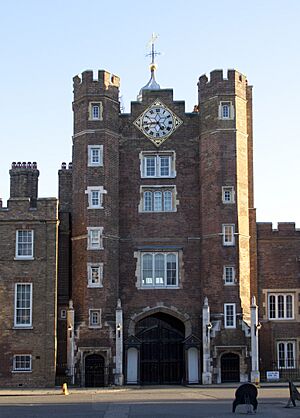
When a monarch dies, the next person in line immediately becomes the new sovereign. There's no need for a special ceremony right away. However, a group called the Accession Council meets to officially announce the new monarch. This announcement is then read out in public places in cities like London, York, and Edinburgh. The day the new monarch takes the throne is called Accession Day, and it's celebrated with things like gun salutes.
The Accession Council usually meets at St James's Palace. The announcement is made in the name of important people like religious leaders, members of the Privy Council, and city officials. When Elizabeth II became queen, her proclamation was the first to mention representatives from the Commonwealth.
When a new monarch takes the throne, they must make several promises. The Bill of Rights of 1689 first required the monarch to publicly state they are not Catholic. This statement, called the Accession Declaration, is made either at the first meeting of Parliament or at their coronation. The words were changed in 1910 to be less harsh towards Catholics. Now, the monarch declares they are a Protestant and will "uphold and maintain" the Protestant succession. The new monarch also promises to "maintain and preserve" the Church of Scotland. This promise is usually made at their first meeting with the Privy Council.
After a period of mourning, the new monarch is usually crowned in Westminster Abbey. The Archbishop of Canterbury usually leads the ceremony. A coronation is not strictly necessary for a monarch to rule; for example, Edward VIII was never crowned, but he was still the king during his short reign.
See also
 In Spanish: Sucesión al trono británico para niños
In Spanish: Sucesión al trono británico para niños


